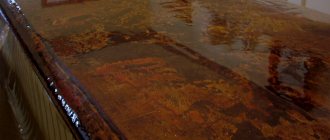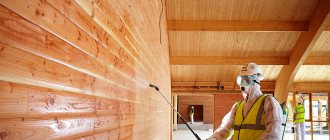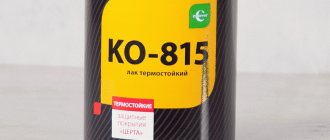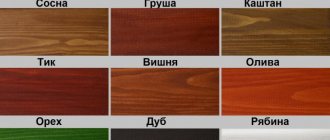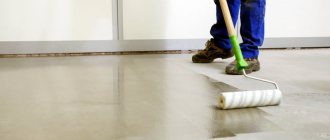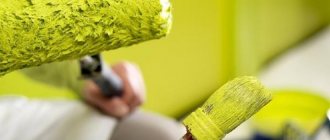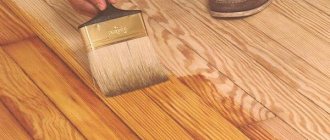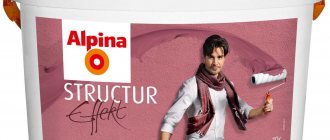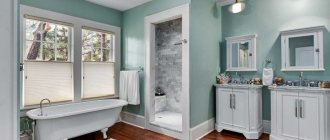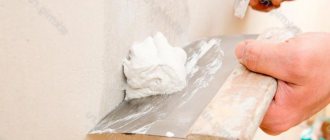If you want to see the facade of your brick house in perfect condition for many years, then coating the brick with varnish will be a good remedy. In our article we will analyze in detail the properties of various types of varnishes for decorative bricks and compile a list of the best manufacturers, talk about application technology (how to prepare the surface, what tools are needed and under what external factors the work can be done). Finally, you will learn about effective preliminary calculation of varnish consumption.
Types of coatings
Of the large assortment of protective products for brick, varnish is popular among citizens involved in repairs. It is believed that the products are equally suitable for all types of brickwork. Construction professionals believe that coatings should differ in their composition. Each surface requires its own complex; individual components are not used anywhere else.
It should be noted that there are several types of brick varnish for interior work:
- Polymeric. This type is used in construction in large quantities. There are nuances: only brick walls are allowed to be coated with the mixture. A layer of varnish protects against rust and corrosion. The composition contains substances that allow you to work with the product even at sub-zero temperatures. The advantage of this type of varnish is that it hardens quickly, which saves time. It is usually used for rooms where heating is not provided. The varnish is easy to apply. After use, you don’t have to worry about corrosion. The price of polymer coatings is affordable for citizens with an average level of income. After application, a transparent film is formed, which is very durable. It reliably protects against various scratches and other possible damage.
- Acrylic-silicone. The product is usually used for interior work. After coating, the wall does not turn yellow over time. Special dyes are added to it, so you can choose any shade. Matte brick varnish is often used for interior work. It helps hide visual defects in the wall. Excellent for application to artificial surfaces. Acrylic coatings are not affected by acetone and even gasoline. They penetrate the structure of the material, providing protection. The coating does not turn yellow over time. There are some minor restrictions. So, it is undesirable to use this product on facades.
- Solvent varnishes. These are compositions to which silicone resin and solvents are added. They penetrate deeper than others into the brick layers, after which the material will not crack. The disadvantage of this group of products is their increased flammability. When working with them, you should follow safety precautions.
- Polyurethane. This is the most versatile type among all solutions. It is used for almost any internal work, including external ones. When the varnish dries, a special film appears. It protects the surface from all possible damage. Dye can be added to the product to create the desired shade. Nowadays it is fashionable to create a “wet stone” effect - it is often used in country houses. Polyurethane varnish belongs to the category of waterproof. It perfectly protects brick walls from moisture and destruction. This type is considered the cheapest on the construction market.
Material properties
First, decide what effect you want to achieve? In the case when your goal is the usual protection of brick walls from atmospheric agents, then choose varnishes intended only for this. If, at the same time, you want to enhance the external attractiveness of the building, pay attention to varnish materials with a decorative effect. With the right choice, a brick wall under varnish can get a matte or glossy surface (up to the “wet stone” effect, popular among residents of our country, due to the use of special additives).
When wondering what varnish to coat a brick wall of a house with, first of all determine the area of the upcoming work. This determines which packages you will need to purchase the varnish in. This material is produced:
When choosing a material, take into account the characteristics of the climatic zone in which the building is located. The greatest demand for paints and varnishes for brick walls, of course, is in areas with harsh climates. For owners of such housing, the following properties of varnishes come to the fore:
In addition, varnished bricks show less soiling, since the additional coating of the building material repels dirt.
Varnish is a truly universal material; it can be used outside and inside (for decorative purposes). When applied, it lays down in an even layer, regardless of whether work is being done on horizontal, vertical or inclined surfaces.
Application Tips
If a person decides not to use the services of specialists, but to apply the product himself, then he should study a number of tips. There are certain rules for applying varnish to bricks for interior work.
The coating should be applied in a thin layer so that several approaches can be made. With this technique of use, drips will not appear. For brightness, it is permissible to paint the seams in a different color (more contrasting). Many useful tips can be found in the instructions for brick varnish for interior work.
Beginning of work
Preparation begins with inspecting the surfaces that need to be painted. All detected cracks and chips must be repaired. Defects may be in the seams between bricks. If the mortar spills out in some places, it must be removed and the cracks filled with fresh cement-sand mixture.
Sealing cracks
In masonry, cracks more than 5 mm wide (especially on load-bearing walls) cannot be repaired independently. They may be the result of shrinkage or another problem and grow.
To eliminate cracks up to 5 mm wide, use:
- solution - 1 part cement M400 (or higher) to 2-3 parts sand;
- ready-made repair composition - you just need to mix it with water;
- mixture - 1 part cement, 1 part liquid glass and 3 parts sand (first dissolve silicate glue in water, then add dry ingredients), make the consistency such that the finished mass does not flow down;
- polyurethane foam;
- sealant;
- epoxy resin.
The gap is widened with a chisel or hammer for better penetration of the repair agent and cleaned with a scarpel. You can moisten the crack inside and out with water from a spray bottle, but it is better to treat it with a primer. The repair compound is applied with a spatula inside the crack and on its surface (so that it protrudes slightly) and the reinforcing tape is pressed into it (if the crack is small, then the tape is not needed). After a few minutes, apply a thin layer of solution on top.
After drying, the surface is polished with a sanding float. Then the masonry is thoroughly cleaned of dust and traces of mold. You can use a wire brush. Efflorescence is removed with a special product (for example, Tiprom OF).
Surface primer
To ensure better adhesion of materials, the wall must be treated with a special brick primer for painting. The primer and paintwork materials must be on the same base, for example, for acrylic paintwork materials there is a similar material. If traces of mold were found during inspection, then choose a composition with antifungal additives. Another argument in favor of primer is that the consumption of paintwork materials is reduced.
First, corners, joints, surfaces behind pipes and other hard-to-reach places are treated with a brush. Then prime the entire wall with a roller. The composition is applied in 2-3 layers, allowing each to dry completely.
What to look for when choosing?
It is important to understand for what purpose you are choosing a product and in what work it will be used. You should first study what is suitable for a particular material - in our case, brick.
The varnish must be moisture resistant. On the market you can see products from different manufacturers of brick varnish for interior use. There is a chance that you will find an option that is suitable in price and quality. The composition will improve the appearance of the brick - it will be brighter.
More and more often you can find colored varnish on bricks for interior work. It is used to add brightness and harmoniously combine the colors of the interior. Some people want a rich red brick color or matte white when decorating a loft-style room. These coatings look great and are of good quality. It is also important to pay attention to the expiration date of the solution.
Features of brick
Artificial stone has long been used as a building material for the construction of houses, fireplaces, and stoves. Its main advantages are versatility, durability, and pleasant appearance. There are several types of bricks. Classifications are common based on two criteria:
- According to the material used. There are clay with filler, ceramic, silicate (sand, lime) products.
- By method of use. There are construction and façade (cladding) products.
This structure is durable. Still, the brick coating can be destroyed under the influence of various factors. Brick is not protected from moisture and is sensitive to chemicals and temperature changes. It becomes dirty and loses its original appearance. Varnishes help preserve the characteristics of the material.
Various bricks
Foreign or Russian
The buyer of brick varnish for interior work always faces a choice of which manufacturer to choose. Some purchase exclusively imported varnishes. There are advantages here: they do not have a strong odor and dry quickly. Also, imported materials are better in operation.
The most popular coatings and varnishes among the population are those produced in the USA. They are produced by Pufas and Petri. These manufacturers have established themselves as successful and reliable suppliers. They have a wide range of products, which are regularly supplied to Russia.
The domestic production of varnishes is also not standing still. Usually universal formulations are created. They are suitable for brick, stone, and are also good at working with concrete. The price of locally produced products also pleasantly pleases the potential buyer, especially when large quantities are purchased. The disadvantage of Russian varnishes is a strong, unpleasant odor that does not dissipate for a long time from the room where the work was carried out. They are not recommended to be used or stored near children. Over time, they began to produce good quality varnishes that perfectly protect brickwork from external damage.
One of the best products is Neomid. It creates a high-quality protective film that even fights the appearance of fungus. Unlike most coatings produced in our country, Neomid does not have a sharp or unpleasant odor. They can easily handle elements located in a small room.
Manufacturers
We bring to your attention the best manufacturers of brick varnishes. The products of these companies demonstrate the ability to withstand high temperatures, precipitation, UV rays and various chemical reagents.
Let’s conditionally put the German brand “Pufas” in first place. This is one of the oldest concerns in the world market of paints and varnishes; today its product range includes over 200 types of finishing materials.
Speaking about Russian companies specializing in the production of paints and varnishes, let us mention the Neomid STONE trademark (also known under the Neomid brand). Among the required qualities of varnishes and impregnations, we highlight the following:
I would also like to note that all Neomid STONE products have no toxic odor, which makes them suitable for interior finishing work.
Let us note that the above-mentioned Russian companies produce their products based on imported raw materials from such famous and others.
Advantages of varnishes
It is worth noting the advantages of using brick varnish for interior work:
- You can advantageously emphasize the texture of a brick wall. The surface will become brighter.
- Perfect for those who want to add color to the interior with varnish.
- There are options to choose from - make the surface glossy or matte.
- You can coat a horizontal surface with varnish. They are also comfortable working on a vertical wall.
- Helps the brick remain intact for a long time. The composition penetrates into the material, preventing it from collapsing. Mold will not penetrate into the brick if the room is damp.
You can see what brick varnish for interior work looks like in the photo.
The surface is glossy and looks beautiful in daylight. Under artificial lighting it shimmers and has a shine. The wall or floors look quite aesthetically pleasing and rich.
Surface preparation
Before applying varnish, you need to clean the brick surface. If there is old finishing material on it, for example, varnish or paint, it must be removed either with a solvent or a hair dryer. Excess cement mortar is knocked down with a hammer and chisel. If there are small cracks, they are sealed with latex brick paint, which, after drying, is removed from the wall using sandpaper. If there are large cracks, they are first expanded, sealed, and then cleaned and sanded. The following steps are followed:
- the surface is washed to remove efflorescence, dirt and dust. This can be done using detergent and a soft foam sponge;
- the wall is drying out. The surface must be completely dry, since varnish cannot be applied to a wet base;
- if efflorescence appears again, they must be removed again using a hard sponge, after which the wall is dried again;
- the surface is treated with deep penetration soil. It is advisable to use a primer from the same manufacturer as the varnish.
Care after applying varnish
After treating the surface with brick varnish, it becomes easy to care for. The wall practically does not get dirty, dust does not settle on it. If there is a fireplace or other appliances nearby, the surface does not become hot. This coating is not afraid of water, it does not wear off for a very long time. During cleaning, it will be enough to wipe the surface with a damp cloth. You can even do without cleaning products. This wall can withstand many washing cycles.
Tools
To paint a brick wall you will need:
- Ladder.
- A special tray (bath) for paint. One of its edges is raised; a brush or roller can be pressed well against the corrugated surface. The width of the tray is selected to match the size of the rollers. If you plan to paint the brick in 2 or more colors, then it is convenient to use liners. When you need to change the shade, simply change one liner to another. Instead of a bath, you can use a paint bucket. There are special grates for squeezing paint on sale.
- Flat paint brushes of different widths. It is convenient to paint brick in horizontal stripes. It is more profitable to buy sets of brushes. Quality control - it is impossible to pull out the lint from good instruments. Polyester bristles are suitable for all types of paints, natural bristles are only suitable for oil, alkyd, and epoxy paints.
- Angled brush (with beveled edge). It can be purchased separately or as a set with flat tools.
- Applicators. These are special devices with which you can carefully paint the joints of walls and ceilings, door and window openings. A special applicator is angular. They use it to paint the joints of walls; the composition is applied to both walls in one motion.
- Paint rollers. They come in different widths, with replaceable coats. The cheapest ones are foam rubber products. They are unsuitable for working with paints containing aggressive solvents; they leave air bubbles on the wall. Velor coats take up little paint. A good option is a fur roller. Short pile for a smooth surface, long for a rough one. For bricks, it is better to use coats with long pile. There are special rollers with plastic loops on sale. They are designed to create decorative effects and are suitable for texture paints.
Varieties
There are 4 types of decorative varnishes for bricks for exterior use: polymer, acrylic, solvent, fireplace/stove and sealing impregnations.
- Polymer. The composition includes alkyd resins, acrylic copolymers, as well as organic solvents and various additives. After treatment with such compounds, brick acquires a beautiful appearance “a la wet stone”, while its wear resistance increases. You can work with polymer varnishes even at low temperatures (down to -10° C).
- Acrylic. Used to protect brickwork during both external and internal work. One-component, organic solvent-based compounds are well absorbed into the brick, protecting it from microcracks, mechanical damage, and preventing the formation of efflorescence.
- Solvent. These are varnishes based on the same solvents with the addition of silicone resins. They penetrate deeply into the brick, creating a durable coating that does not crack, peel, or fade. Solvent varnishes are a fire hazard, so you need to work with them with extreme caution.
- Fireplace/stove. KO-85 or KO-815 are special fire-resistant varnishes. They are used for both external and internal work (strengthening the internal surfaces of fireboxes and protecting against condensation). The application of such varnishes gives brick walls heat resistance and water-repellent properties, prevents washing out of stove seams, and strengthens the masonry of a stove or fireplace.
- Sealing impregnations. Produced on the basis of silicone and acrylic resins, they give the brick maximum resistance to wear. The impregnation is fluid due to a complex mixture of aromatic and aliphatic solvents, which ensures its high penetrating ability. This coating does not turn yellow for many years. The protective layer obtained as a result of processing is resistant to water, chemicals, UV rays, oils, and reagents. After application and drying, it gives the brick an unobtrusive shine with a “wet stone” effect.
Process of painting a brick wall
It is recommended to paint brick facades in the summer, in dry weather, at a temperature not exceeding +25°C. Inside the house, finishing can be done at any time of the year. Before starting work, furniture and household appliances are removed from the room, and heavy objects are covered with film. The joints between the walls and the floor, ceiling, window and door openings are sealed with masking tape (delicate tape). This is necessary to prevent the formation of drips and smears on surfaces in contact with the walls. Plain adhesive tape cannot be used, because peeling it off will damage the coating.
Instructions for painting with a roller:
- Work begins from any corner, indoors - from the side of the windows.
- Apply paint with a brush along the perimeter of the walls, behind pipes and heating radiators, and in other places inaccessible to a roller.
- The entire surface is painted with a roller in strips of 70-100 cm. Each subsequent strip must be applied to the not yet dry adjacent strip, overlapping with an overlap of up to 10 cm. If there is no experience in painting work, due to the slowness, the previous strip of paint has time to dry - when applying the next one, the roller will tear off the coating. In this case, it is better to paint together.
To obtain a dense coating, 2 layers of good paint are enough - when using cheap paints and varnishes, a third may be needed.
If, after drying, spots appear on the painted wall, then another layer of paint and varnish is applied to the entire surface. The paint is made more liquid than on the main layers. If the stains persist, you will have to sand the entire wall again and repaint it.
